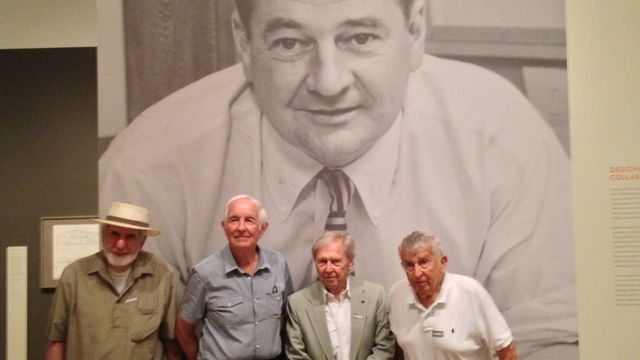
Flash Talk: A. Quincy Jones’ Former Students
In conjunction with the current exhibition A. Quincy Jones: Building for Better Living on view through September 8, 2013
Thursday, July 18, 2013 | Gallery 4
USC Class of ’52 Reunion to Honor Former Professor A. Quincy Jones
1952. The year Singin’ In The Rain was released, Kellogg’s Frosted Flakes were introduced in grocery stores, and the Big Bang Theory of the universe was first proposed. This was also the year Frank Mosher, J. V. Ouzounian, Don Park, and Robert Tyler took a fifth-year design class at the University of Southern California (USC) taught by none other than A. Quincy Jones. More than a half of a century after their graduation, the four architects had a class reunion on July 18 in Hammer Gallery 4 and shared their experiences with museum staff and visitors—the A. Quincy Jones: Building for Better Living exhibition quite appropriately serving as the backdrop to the Flash Talk.
The former students of Jones had nothing but kind words to say about their mentor. “I remember he was very personable and very into us,” Ouzounian said matter-of-factly. “On the first day of class, he told us ‘I’m more afraid of you than you are of me!’” And Park, who remained close to Jones after his time at USC added, “I worked for Quincy for several years. He was easy going and everybody had a good time as well as worked hard; I learned a lot.” I suppose someone who reached the end of his life with over 5,000 built projects would have to be easy going, or else the stress of putting up so many buildings would get to him.
Hammer curatorial fellow Ellen Donnelly, who moderated the Flash Talk, asked the architects whether or not they felt Jones had a preference over the types of buildings he designed (restaurants, homes, churches, etc.). And in unison, not unlike the manner of a barber shop quartet, the four responded with, “He was interested in everything!” They went on about how Jones could never pick a favorite building. He loved them all. And so did those who had the opportunity to live and work in them. “The plans worked, they were designed for people,” Tyler said. Which explains why mid-century design is making a comeback in architecture today. “People just want livable buildings—designed from the inside out and not the outside in,” Mosher said.
Jones was an avid sketcher, as his job demanded, but he often found himself doing it out of the office too. “[Jones] was a very warm person; I would always get Christmas cards with his sketches,” Mosher said, prompting Donnelly to tell us about the yearly travel sketches Jones sent to friends, family, and former students. But he didn’t sketch his plans for buildings all on his own. Kaz Nomura, who according to Tyler “could draw with two hands at the same time,” sketched ambidextrously alongside Jones quite often.
And Jones was quick to give credit where it was due. Mosher explained how he recognized all who worked with him. “There was a book on architecture that came out and it listed everyone who has ever worked for him in the back,” Ouzounian added. Donnelly touched on Jones’ philosophy that there shouldn’t be titles in the office, just shared experiences. And 61 years later, Frank Mosher, J. V. Ouzounian, Don Park, and Robert Tyler are still keen on their shared experiences with A. Quincy Jones.
--Neyat Yohannes, Communications + Public Engagement Intern
Neyat is a third year student at Emerson College working towards a BFA in Writing, Literature, and Publishing and a minor in Visual Studies.




